

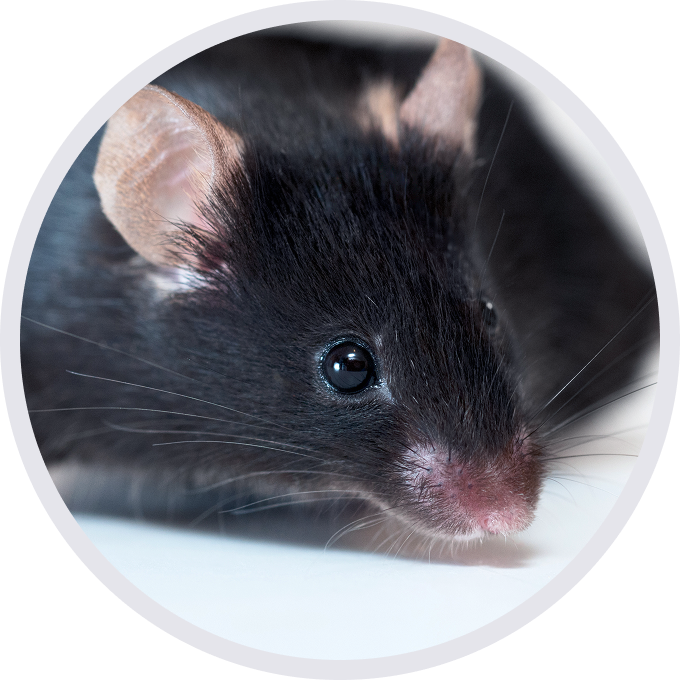
C57BL/6N-Fcgr4tm3(FCGR3A)Bcgen/Bcgen • 112446
| Product name | B-hCD16A mice plus |
|---|---|
| Catalog number | 112446 |
| Strain name | C57BL/6N-Fcgr4tm3(FCGR3A)Bcgen/Bcgen |
| Strain background | C57BL/6N |
| NCBI gene ID | 2214 (Human) |
| Aliases | CD16, FCG3, CD16A, FCGR3, IGFR3, IMD20, FCR-10, FCRIII, CD16-II, FCGRIII, FCRIIIA, FcGRIIIA |
Gene targeting strategy for B-hCD16A mice plus. The exons 1-5 of mouse Fcgr4 gene that encode signal peptide, extracellular domain and transmembrane domain are replaced by human counterparts in B-hCD16A mice plus. The genomic region of mouse Fcgr4 gene that encodes cytoplasmic portion is retained. The promoter and 5’UTR region of the mouse gene are replaced by human counterparts.
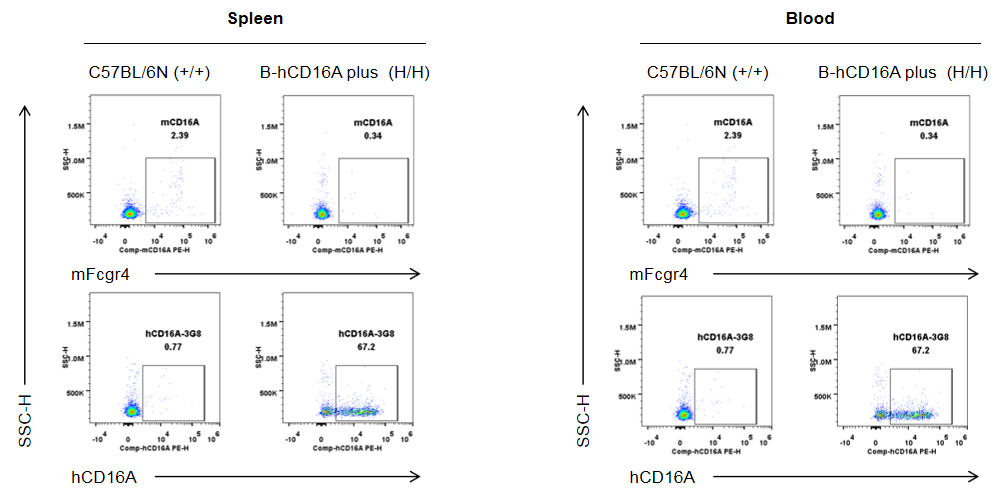
Strain specific human CD16A and mouse Fcgr4 expression analysis in wild-type C57BL/6N mice and homozygous humanized B-hCD16A mice plus by flow cytometry. Splenocytes and blood cells were collected from wild-type C57BL/6N mice (+/+) and homozygous B-hCD16A mice plus(H/H) (male, 8-week-old, n=1). Protein expression was analyzed with anti-mouse Fcgr4 antibody (Biolegend, 149503) and anti-human CD16 antibody (Biolegend, 302008) by flow cytometry. Mouse Fcgr4 was not detectable in NK cells of wild-type C57BL/6N mice. Human CD16A was exclusively detectable in NK cells of homozygous B-hCD16A mice plus, but not in wild-type C57BL/6N mice.
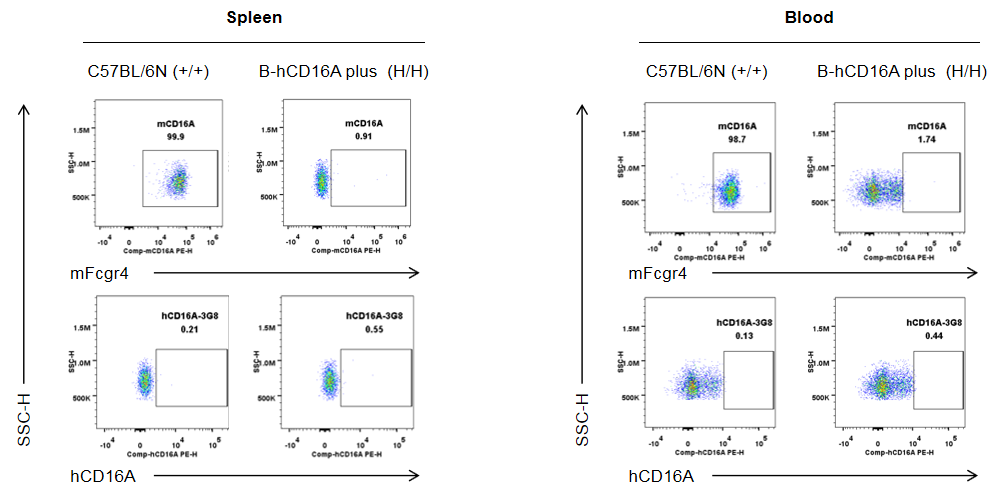
Strain specific human CD16A and mouse Fcgr4 expression analysis in wild-type C57BL/6N mice and homozygous humanized B-hCD16A mice plus by flow cytometry. Splenocytes and blood cells were collected from wild-type C57BL/6N mice (+/+) and homozygous B-hCD16A mice plus(H/H) (male, 8-week-old, n=1). Protein expression was analyzed with anti-mouse Fcgr4 antibody (Biolegend, 149503) and anti-human CD16 antibody (Biolegend, 302008) by flow cytometry. Mouse Fcgr4 was exclusively detectable in granulocytes of wild-type C57BL/6N mice. Human CD16A was not detectable in granulocytes of homozygous B-hCD16A mice plus.
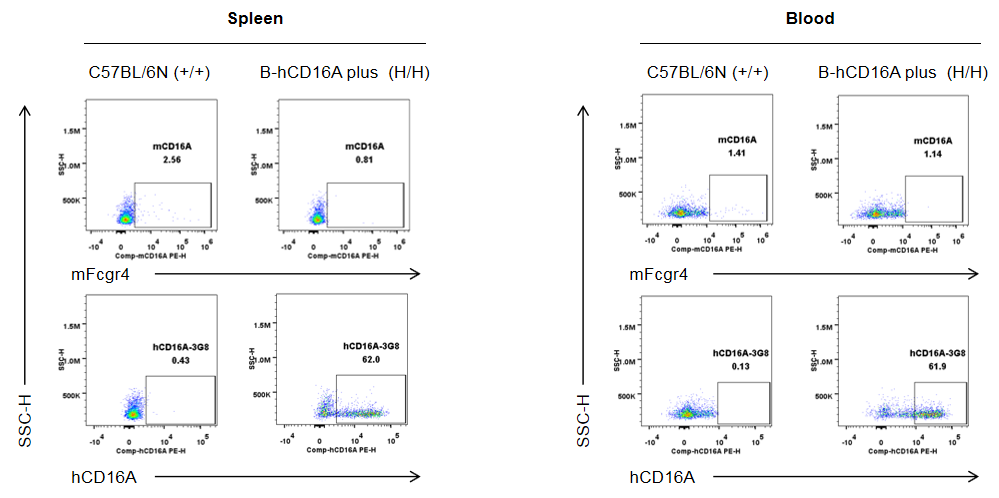
Strain specific human CD16A and mouse Fcgr4 expression analysis in wild-type C57BL/6N mice and homozygous humanized B-hCD16A mice plus by flow cytometry. Splenocytes and blood cells were collected from wild-type C57BL/6N mice (+/+) and homozygous B-hCD16A mice plus(H/H) (male, 8-week-old, n=1). Protein expression was analyzed with anti-mouse Fcgr4 antibody (Biolegend, 149503) and anti-human CD16 antibody (Biolegend, 302008) by flow cytometry. Mouse Fcgr4 was not detectable in monocytes of wild-type C57BL/6N mice. Human CD16A was exclusively detectable in monocytes of homozygous B-hCD16A mice plus.
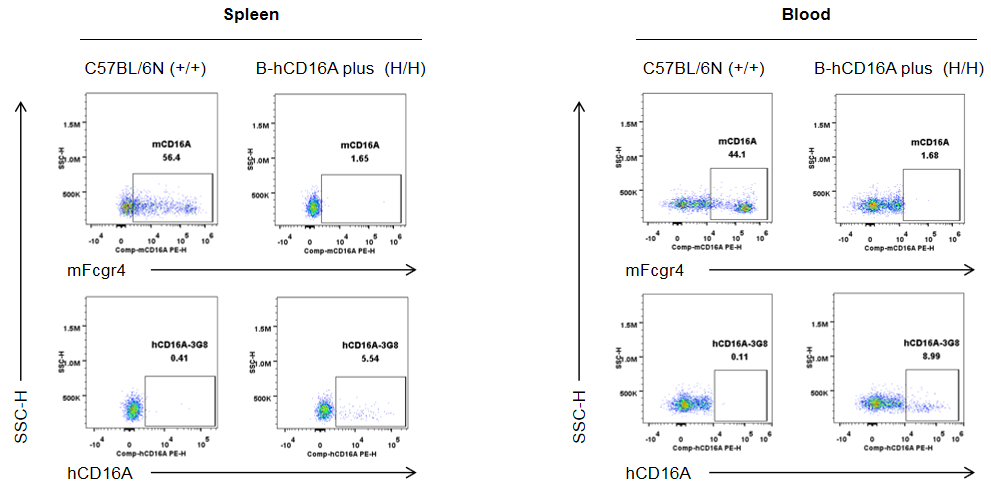
Strain specific human CD16A and mouse Fcgr4 expression analysis in wild-type C57BL/6N mice and homozygous humanized B-hCD16A mice plus by flow cytometry. Splenocytes and blood cells were collected from wild-type C57BL/6N mice (+/+) and homozygous B-hCD16A mice plus(H/H) (male, 8-week-old, n=1). Protein expression was analyzed with anti-mouse Fcgr4 antibody (Biolegend, 149503) and anti-human CD16 antibody (Biolegend, 302008) by flow cytometry. Mouse Fcgr4 was exclusively detectable in macrophages of wild-type C57BL/6N mice. Human CD16A was exclusively detectable in macrophages of homozygous B-hCD16A mice plus.
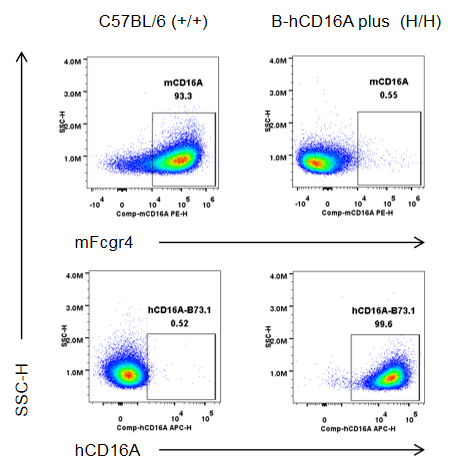
Strain specific human CD16A and mouse Fcgr4 expression analysis in wild-type C57BL/6N mice and homozygous humanized B-hCD16A mice plus by flow cytometry. Peritoneal exudative macrophages(PEMs) were collected from wild-type C57BL/6N mice (+/+) and homozygous B-hCD16A mice plus(H/H) (male, 8-week-old, n=1). Protein expression was analyzed with anti-mouse Fcgr4 antibody (Biolegend, 149503) and anti-human CD16 antibody (Biolegend, 302008) by flow cytometry. Mouse Fcgr4 was exclusively detectable in macrophages of wild-type C57BL/6N mice. Human CD16A was exclusively detectable in macrophages of homozygous B-hCD16A mice plus.